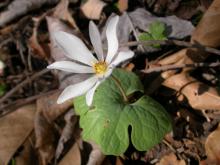Wildflowers, Grasses and Other Nonwoody Plants
Media

Species Types
Scientific Name
Ophioglossum spp.
Description
Four species of adder’s tongue ferns occur in Missouri. They don’t look like typical ferns. They have spoon-shaped leaves and an upright spore-bearing stalk.
Media
Species Types
Scientific Name
Vernonia baldwinii
Description
Ironweeds are tough, grayish-green, branching plants known for their fluffy-looking clusters of reddish-purple florets. They are a familiar sight on roadsides and pastures. Identify western ironweed by the bracts at the base of the flowerheads.
Media

Species Types
Scientific Name
Silene virginica
Description
Fire pink is a low, clump-forming perennial with many slender, spreading stems that are sticky from glandular hairs, with open clusters of bright red flowers. This showy native Missouri plant is growing in popularity among home gardeners.
Media

Species Types
Scientific Name
Alliaria petiolata
Description
Because each plant disperses a large number of seeds, garlic mustard can outcompete native vegetation for light, moisture, nutrients, soil, and space as it quickly colonizes an area.
Media

Species Types
Scientific Name
Claytonia virginica
Description
Our most widely distributed early spring flower, spring beauty has 5 white or pink petals with distinct pink veining, and 5 pink anthers. The narrow, bladelike leaves are fleshy. These flowers often grow in abundance, covering a patch of ground with the beauty of spring.
Media

Species Types
Scientific Name
Sanguinaria canadensis
Description
Bloodroot’s pure white petals are even more remarkable given the plant’s bright red sap. This feature, plus the unique leaf shape, make this early spring wildflower easy to identify.
Media

Species Types
Scientific Name
Anemone canadensis
Description
White anemone is a showy native wildflower with interesting, deeply toothed leaves. Often occurring in colonies, it spreads easily (even aggressively) from rhizomes and is sometimes cultivated in wildflower gardens.
Media

Species Types
Scientific Name
Camassia scilloides
Description
In spring, wild hyacinth bears an elongated cluster of pale blue flowers with prominent anthers that sway on stalks up to 2 feet tall.
Media

Species Types
Scientific Name
Campanula americana
Description
Tall bellflower is an abundant native bellflower that is easily identified by its stout, tall habit, short, wheel-shaped, blue corolla, and the curved, purple style that projects beyond the flower.
Media

Species Types
Scientific Name
Ageratina altissima (formerly Eupatorium rugosum)
Description
White snakeroot looks very similar to thoroughworts, but it has triangular leaf blades that are more broadly angled or rounded at the base. White snakeroot is common statewide. It’s a toxic plant if eaten, so it’s good to be able to identify it.
See Also
About Wildflowers, Grasses and Other Nonwoody Plants in Missouri
A very simple way of thinking about the green world is to divide the vascular plants into two groups: woody and nonwoody (or herbaceous). But this is an artificial division; many plant families include some species that are woody and some that are not. The diversity of nonwoody vascular plants is staggering! Think of all the ferns, grasses, sedges, lilies, peas, sunflowers, nightshades, milkweeds, mustards, mints, and mallows — weeds and wildflowers — and many more!





















